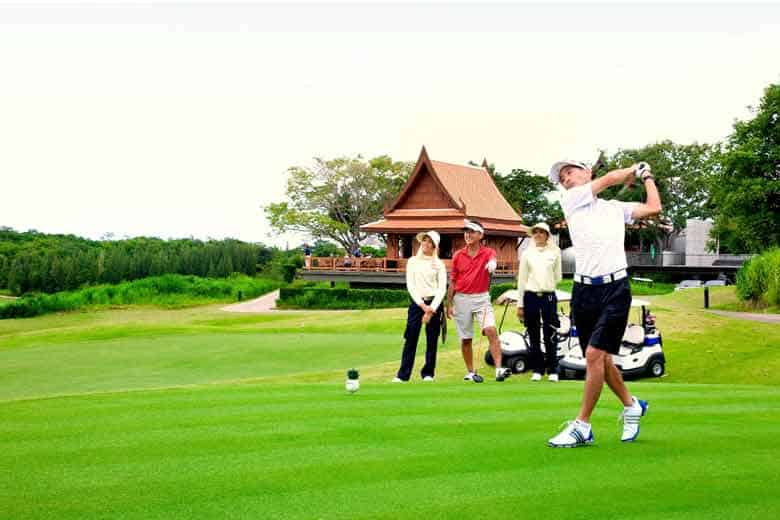Thailand is poised to topple Spain as the most-visited golf destination in the world.

The government gets into the act, too—in August and September every year—as TAT bandies together all the golf courses for the ‘Golf Week’.
Even by conservative estimates, the number of golf tourists to Thailand in 2015 is expected to cross the one-million figure—over 100,000 more than 2014—which will propel the south-east Asian golf haven to the apex of the golf tourism industry. Not only will Thailand become the first Asian country to do so, but it’ll surpass, or at least equal, Spain, which has been the world’s favourite golf destination for over a decade.
In 2014, tourists who visited Thailand specifically to play golf, or played golf as part of a wider array of activities in Thailand, brought in an astounding $1.2 billion in revenue to the country’s coffers and that figure is expected to go up significantly this year. To get a relative sense, that’s over 3% of the $39.5 billion, which is what tourism in Thailand generated in 2014. One would think that’s reason enough for golf operators, golf course owners and other representatives from industries connected with the golf boom in Thailand to celebrate; but you could have heard a pin drop in the cavernous meeting halls of Dust Thani hotel in Hua Hin last month, where the Thailand Golf Travel Mart was being held. Over 1,000 delegates from the country—which included literally everyone and anyone connected with the golf industry, and their counterparts from regions as far afield as Scandinavia and Australia—were in attendance, as speaker after speaker outlined challenges, proposed innovations and lobbied with government agencies for further refining the itinerant golfer’s experience in Thailand.
Your columnist was there as part of an international media contingent, which admittedly, had been baited adroitly by the Tourism of Thailand (TAT) on the promise of teeing it up at no less than three of the best courses in Hua Hin (Black Mountain GC, Springfield GC and Banyan GC) and one in Bangkok (Suwan GC) thrown in for good measure. I must digress here to give my take on TAT’s new refrain: ‘Discover Thainess’, at least as the tourism body would like to define it, is a reference to the well-known Thai hospitality. But, if you ask me, it goes much further than that. I think ‘Thainess’, as amply demonstrated on this occasion, also means a thoughtful strategy to incorporate other people’s agendas in order to promote their own—we went for the golf, but were inexorably drawn in by the symposium.
Hua Hin is the perfect microcosm to gain an insight into Thailand’s golf ecology—why it draws as many tourists as it does; what those players’ experiences are like; and why these people get converted into repeat visitors. The small seaside resort town is known as the official residence of His Highness, King Bhumibol Adulyadej, and is a favourite weekend getaway for wealthy Thais from Bangkok who have summer homes here. Considering the town’s size—easily traversable within 30 minutes—its wealth of offerings for golfers surpasses even the allure that Delhi—India’s best city for golfing—presents. Over 12 championship golf courses, out of which the three I mentioned earlier, are truly world-class.
There are five differentiators that are easily identifiable within just three days of playing golf in Hua Hin, and these represent the differentiators of the golfing experience in Thailand: quality, diversity, climate, value and access. Of these, variety is the most apparent: from the highlands of Chiang Mai, to the beach courses in Phuket, to the tropical forests of Khao Yai, there are at least 10 bonafide golf destinations in the country. The climate is largely tropical and at least as far as the islands are concerned, a cool sea breeze means teeing it up is possible in salubrious climes for most of the year. Bookings are easy and can be done online. The clubhouses are spectacular and equipped with excellent F&B facilities. And, most importantly, the caddies are professional and polite. These are small things, but things you can’t take for granted in India.
The government gets into the act, too—in August and September every year—as TAT bandies together all the golf courses for the ‘Golf Week’. During this week, visiting golfers get a standardised green fee rate at most courses in the city (excepting Black Mountain), which is considerably lower than usual. This year, it’s THB1000 (including caddy and cart!), which is an unsurpassable deal for courses of this calibre. In fact, there’s still time to make a quick dash for a long weekend to Hua Hin for those who can get away.
As a post-script, it is relevant to mention the unfortunate blast that took place at the Erawan Shrine in Bangkok scarcely a fortnight after my return. Not only did I stay at a hotel a short walk from the site, but actually spent an hour within the shrine—in over 30 trips, which I’ve made to Thailand over the past decade, this was the first time ever that a tragedy like this cast a long shadow on the country. So does that mean that I may not be going back? On the contrary, I feel an urgent need to go back at the first possible opportunity and return to the shrine to exorcise any such demons that may threaten to change how I feel about Thailand. If there’s one more shining facet of ‘Thainess’, it’s the indefatigable ability of the Thais to snap back from any tragedy—whether it’s the Bangkok floods or the recent civil disobedience. I’m pretty certain, Thailand will still become the world’s top golf destination this year. For the itinerant swinger, the country’s surfeit and diversity of championship layouts, top-notch hospitality and value-for-money appeal are just too overwhelming to resist.
 +66 62 62 62 600
+66 62 62 62 600